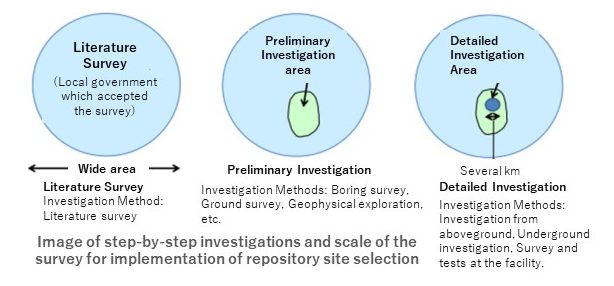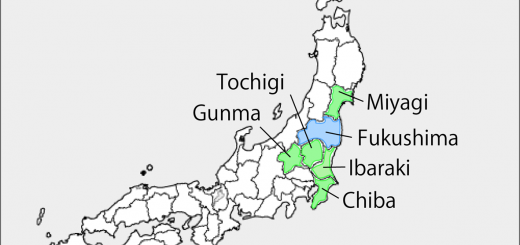CNIC Statement: NUMO Should Resubmit its Report on the Literature Survey
November 26, 2024
On November 22, the Nuclear Waste Management Organization of Japan (NUMO) submitted its report on the literature survey, the first phase of the survey for the construction of a final disposal site for high-level radioactive waste, to the mayor of Suttsu Town, Mr. Kataoka Haruo; the mayor of Kamoenai Village, Mr. Takahashi Masayuki, and the Governor of Hokkaido, Mr. Suzuki Naomichi. The draft of the report was presented in February this year at the Geological Disposal Technical Working Group (Technical WG), a council of the Ministry of Economy, Trade, and Industry (METI), and deliberations were conducted five times up to August. The survey began in both the town and the village in November 2020. Although literature surveys generally require about two years, NUMO spent four years completing this report. However, the fact that NUMO completed the report while ignoring important new findings could lead to a decline in the credibility of the whole process of geological disposal.
On October 16, Professor Emeritus Okamura Satoshi of Hokkaido University of Education presented the results of the dating of the Isoya lava located in the eastern part of Suttsu Town at the Volcanological Society of Japan. According to the report, the age of lava activity of the Isoya lava is from about 2.1million years ago to about 3.3million years ago. Hence it can be regarded as a Quaternary volcano that was active after about 2.58million years ago. According to the “Evaluation Approach for the Literature Review Phase,” which was formulated by the government in November 2023, areas within 15km of the activity centers of Quaternary volcanoes are to be avoided as final disposal sites. Therefore, if the Isoya lava is a Quaternary volcano, the impact of this finding may be significant, as most of Suttsu Town falls within that area. In addition, it was reported in the Hokkaido Shinbun newspaper on November 15 that Professor Geshi Nobuo at Kyushu University, who is vice president of the Volcanological Society of Japan as well as a member of the Technical WG, stated his opinion that “it should be treated as a Quaternary volcano,” and “if the knowledge had been obtained before deliberations on the report had been completed, the Isoya lava would have been excluded from the preliminary investigation area.”
In June this year, the Technical WG completed the “Report on Deliberations concerning the Technical and Specialized Perspectives Based on the Statement on Geological Disposal.” This is a summary of the deliberations of the technical and professional perspectives of the statement by more than 300 geological researchers who are critical of geological disposal in Japan. In the summary of this report, it is stated that “it is important for the government and NUMO to share with the public the recognition that in the step-by-step survey process for selecting the disposal sites, information should be repeatedly confirmed in the discussions and in some cases stopped and reset,” and “it is essential to refer to the knowledge of experts who are familiar with the geology of regions being surveyed.” Looking back, the “Radioactive Waste WG Interim Report,” which was compiled in May 2014, also pointed out that “it is essential to ensure reversibility and retrievability, and to establish a system that decision-making regarding final disposal can be reviewed, including by future generations.” In particular. reversibility is defined as “the ability to withdraw or reconsider decisions made during the implementation of the disposal system.” In other words, in geological disposal projects, it is required to have the flexibility to reconsider plans even after they have become quite firm. At the literature survey stage, “desk research based on literature and data, such as geological maps and academic papers” is carried out. Although the report does not indicate the duration of the survey, it is considered that the survey was completed at the latest in February, when the draft report was presented at the Technical WG. However, since such an important finding has been confirmed, we believe it may have been necessary for the government and NUMO to “stop and reset,” even if only to put the point made by the Technical WG and the Radioactive Waste WG into practice.
Parallel to the literature survey, NUMO was conducting “communication gatherings” with local residents to discuss the disposal project and the future vision of town development. However, numerous problems were identified in the management of these “communication gatherings,” giving rise to a serious sense of distrust regarding NUMO by the residents. The fact that NUMO completed the report in this situation could lead to the suspicion that they wanted to avoid reflecting the result of the Isoya lava dating in the literature survey.
There are also many other points in the literature review report which lack a scientific attitude. To give an example, NUMO evaluated only the Shirozumi which constitutes a part of the Kuromatsunai Lowland fault zone in the southern part of Suttsu Town. As a result, NUMO designated it as a “point of concern” that may indicate that the area falls under the criteria for areas in which selection of a geological disposal site should be avoided, but nevertheless included it in the candidate areas for the preliminary investigation.
On the other hand, Mr. Osada Masahiko, a committee member of the Technical WG, submitted a written opinion stating it would be preferable to remove the region on the Kuromatsunai Lowland fault zone line from the preliminary survey area. Further, in the Nationwide Map of “Scientific Features” created by the government in 2017, the Shirozumi fault is colored orange, indicating that the region is unfavorable for geological disposal. Fundamentally, wasn’t the literature review designed to investigate in more detail the areas indicated in the “Scientific Features” map as being relatively suitable and screen out areas where a preliminary survey could be conducted? To the contrary, areas indicated as having low suitability on the “Scientific Features” map have been picked out rather than screened out.
In order to create the “Scientific Features” map, the Technical WG at the time compiled the Summary of Requirements and Criteria for the Nationwide Map of “Scientific Features” for Regions for Geological Disposal. It stated that “as the stages progress from the Literature Survey, to the Preliminary Investigation and on to the Detailed Investigation, the scope of the investigation will be narrowed down step-by-step,” as shown in the figure below. Nevertheless, this literature survey report does not even exclude unsuitable areas. In this case, it looks more like the area indicated as having a low suitability on the “Scientific Features” map has been picked out.
In the background to this, as stated in the report, there is a policy of “the impacts of wide-area natural phenomena such as active faults and volcanoes are to be identified at the preliminary survey stage and are excluded from the scope of the following detailed investigation.” In this case, the literature survey has no meaning except as “communication gatherings.”
Even if it looks like a roundabout way of doing things, from the perspective of improving public confidence in the geological disposal process as a whole, the government and NUMO should not have completed the literature survey report while disregarding Professor Okamura’s new findings. It was also a great opportunity to actually put into practice the “reversibility” of the process. We believe it is still not too late for NUMO to revise the report.
Related Information on NUMO’s website:


